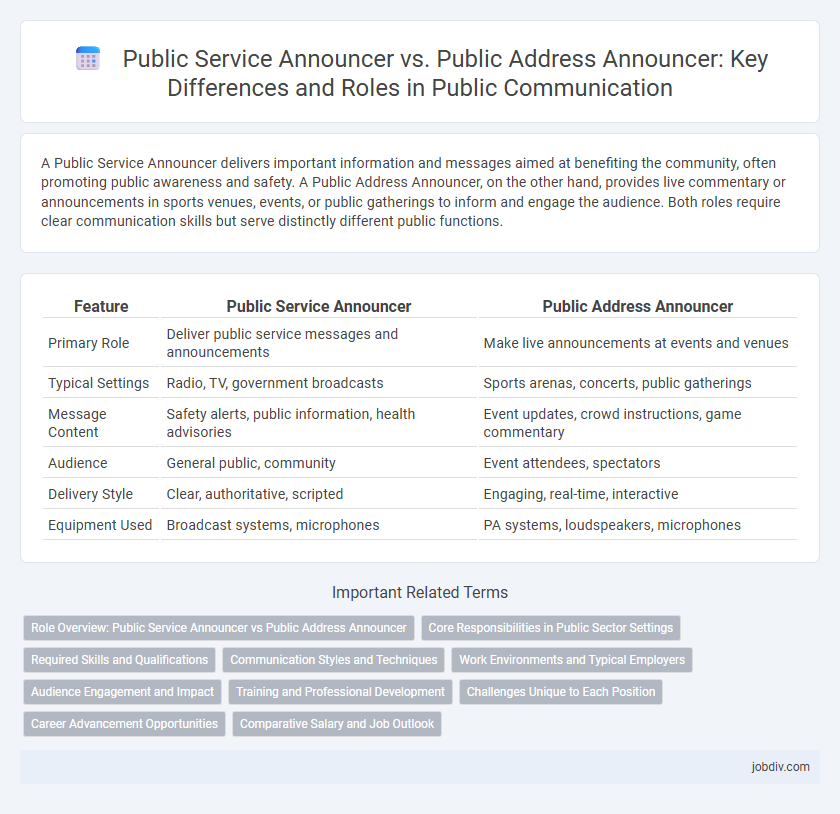A Public Service Announcer delivers important information and messages aimed at benefiting the community, often promoting public awareness and safety. A Public Address Announcer, on the other hand, provides live commentary or announcements in sports venues, events, or public gatherings to inform and engage the audience. Both roles require clear communication skills but serve distinctly different public functions.
Table of Comparison
| Feature | Public Service Announcer | Public Address Announcer |
|---|---|---|
| Primary Role | Deliver public service messages and announcements | Make live announcements at events and venues |
| Typical Settings | Radio, TV, government broadcasts | Sports arenas, concerts, public gatherings |
| Message Content | Safety alerts, public information, health advisories | Event updates, crowd instructions, game commentary |
| Audience | General public, community | Event attendees, spectators |
| Delivery Style | Clear, authoritative, scripted | Engaging, real-time, interactive |
| Equipment Used | Broadcast systems, microphones | PA systems, loudspeakers, microphones |
Role Overview: Public Service Announcer vs Public Address Announcer
Public Service Announcers deliver scripted messages aimed at informing or educating the public on safety, health, and community issues through various media platforms. Public Address Announcers provide real-time verbal updates and instructions in venues such as stadiums, airports, or transit stations to manage crowds and enhance event experiences. Both roles require clear communication skills but differ primarily in their mediums and immediacy of message delivery.
Core Responsibilities in Public Sector Settings
Public Service Announcers primarily focus on delivering informational messages related to public safety, health alerts, and community programs, ensuring timely dissemination to foster public awareness and compliance. Public Address Announcers manage live announcements in various public venues, coordinating event information, crowd control instructions, and emergency notifications to maintain order and safety. Both roles require clear communication skills, but Public Service Announcers emphasize broadcast media outreach, while Public Address Announcers specialize in direct audience interaction within physical spaces.
Required Skills and Qualifications
Public Service Announcers require strong communication skills, a clear and authoritative voice, and the ability to convey important information accurately during emergencies or public events. Public Address Announcers need excellent vocal projection, timing, and crowd engagement capabilities to effectively deliver information in sports arenas, schools, or public venues. Both roles demand proficiency in audio equipment operation, quick decision-making, and adaptability to varying public environments.
Communication Styles and Techniques
Public Service Announcers use clear, concise language to deliver important information quickly, often employing a calm and authoritative tone to enhance trust and urgency. Public Address Announcers emphasize vocal projection, pacing, and articulation to effectively reach large audiences in real-time settings, utilizing repetition and strategic pauses to maintain attention. Both roles require adapting communication techniques to ensure messages are understood and impactful within their specific public environments.
Work Environments and Typical Employers
Public Service Announcers typically work within government agencies, non-profit organizations, and community service departments where they deliver informational messages aimed at public welfare and safety. Public Address Announcers are commonly employed in sporting venues, transportation hubs, and entertainment arenas, providing real-time announcements related to events, schedules, and crowd management. Both roles require clear communication skills but differ significantly in their work environments and typical employers.
Audience Engagement and Impact
Public Service Announcers deliver critical information to the community, enhancing audience engagement by providing timely updates on safety, health, and welfare issues. Public Address Announcers focus on live event communication, using clear and dynamic voice projection to maintain attention and guide audience behavior effectively. Both roles significantly impact public awareness but differ in medium and immediacy of audience interaction.
Training and Professional Development
Public Service Announcers receive specialized training in clear and empathetic communication to effectively convey important information to the community, focusing on public safety and awareness campaigns. Public Address Announcers undergo professional development emphasizing voice modulation, crowd engagement techniques, and real-time event updates to enhance audience experience in venues like stadiums and theaters. Both roles prioritize continuous skill enhancement but cater to different contexts--one centers on public information dissemination, while the other focuses on live event announcements.
Challenges Unique to Each Position
Public Service Announcers face challenges such as delivering clear, concise messages that effectively reach diverse audiences, often under strict time constraints and regulatory guidelines. Public Address Announcers must manage live event dynamics, ensuring accurate, real-time communication despite potential technical issues or crowd noise interference. Both roles require strong vocal skills and adaptability, yet Public Service Announcers emphasize message clarity and compliance, while Public Address Announcers prioritize immediacy and environmental responsiveness.
Career Advancement Opportunities
Public Service Announcers often advance through roles in government agencies or nonprofit organizations, leveraging expertise in public communication and policy promotion to move into senior communications or public relations positions. Public Address Announcers typically progress within entertainment, sports, or transportation industries by honing their vocal presentation skills, leading to opportunities as event coordinators, media broadcasters, or stadium managers. Career advancement for both roles depends on strong communication skills, industry knowledge, and the ability to engage and inform diverse audiences effectively.
Comparative Salary and Job Outlook
Public Service Announcers typically earn an average salary ranging from $40,000 to $60,000 annually, with steady job growth driven by government and nonprofit sectors' demand for community engagement. Public Address Announcers usually have a lower average salary, often between $25,000 and $45,000 per year, with job opportunities concentrated in sports venues and events, showing slower growth. Salary differences largely reflect the broader responsibilities and formal communication roles of Public Service Announcers compared to the event-specific focus of Public Address Announcers.
Public Service Announcer vs Public Address Announcer Infographic

 jobdiv.com
jobdiv.com